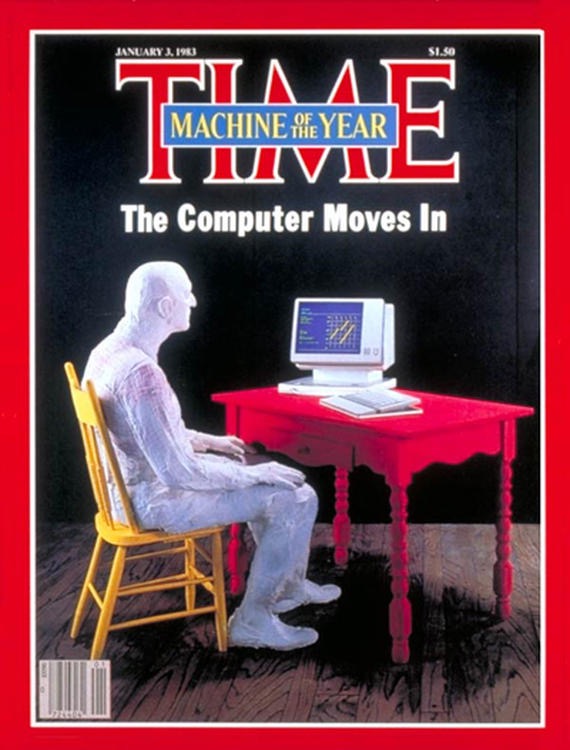There’s a running gag in Steve Jobs, the Danny Boyle/Aaron Sorkin faux-biopic that stunk up the box office so bad it was yanked last week from more than 2,000 theaters.
It’s about the January 3, 1983 issue of Time magazine that has a computer—and not Steve Jobs’ face—on the cover.
In the movie, Jobs is irritated to find boxes full of the magazine piled up backstage just before his 1984 Macintosh keynote. In real life, Jobs was devastated by that issue, and it taught him a powerful lesson about journalists that he never forgot.
Walter Isaacson, who was a junior editor at Time in 1983, tells the story in the biography on which the movie was loosely based.
“As 1982 drew to a close,” Isaacson begins, “Jobs came to believe that he was going to be Time‘s Man of the Year.”
The word in the Time/Life building, where I was an even more junior writer, was that managing editor Ray Cave was waiting until the last minute to choose between Jobs and the magazine’s first “Machine of the Year.”
That rumor turned out to be a subterfuge. “We never considered Jobs,” Cave later told Isaacson.
But nobody told Steve Jobs, who had given Michael Moritz, then a correspondent in Time‘s San Francisco bureau, extraordinary access to Apple’s (APPL) inner workings.
“They FedExed me the magazine,” Jobs says in Isaacson’s book, “and I remember opening the package, thoroughly expecting to see my mug on the cover, and it was this computer sculpture thing. I thought ‘Huh?’ And then I read the article [about him], and it was so awful that I actually cried.”
Part of what made the piece so awful is that it revealed that Jobs had a daughter named Lisa whose paternity he vehemently denied, despite a positive blood test. “Twenty-eight percent of the male population of the United States could be the father,” he told Time.
Jobs believed he had been betrayed by Moritz (“he was jealous and … wrote this terrible hatchet job. So the editors in New York get this story and say, ‘We can’t make this guy Man of the Year’”).
Moritz, for his part, felt he had been betrayed by Jay Cocks, the writer who turned his rich reporting into a sprightly—but cruel—2,600-word story.
“It was hard to say who was more incensed, Jobs or me,” Moritz wrote many years later in his book Return to The Little Kingdom. “Steve rightly took umbrage over his portrayal and what he saw as a grotesque betrayal of confidences, while I was equally distraught by the way material I had arduously gathered was siphoned, filtered, and poisoned with gossipy benzene by an editor in New York whose regular task was to chronicle the wayward world of rock-and-roll music.”
Moritz left the magazine as soon as he could and became a partner at the venture firm Sequoia Capital, where he helped launch, among other companies, Google (GOOGL), Yahoo (YHOO), PayPal (PYPL) and YouTube.
Jay Cocks became a Hollywood screenwriter (The Age of Innocence, Strange Days, Gangs of New York, De-Lovely and an uncredited rewrite of Titanic.)
Jobs went on to appear on the cover of countless other magazines, including Time and Coins2Day. But he also learned what he told Isaacson was “a good lesson. It taught me never to get too excited about things like that, since the media is a circus anyway.”
The Updated Book of Jobs, as reported by Moritz and written by Cocks, is available (for a price) in Time‘ s archives and excerpted (for free) here. The Computer Moves In, the story that ended up on the cover, and which I helped report, was written by the late Otto Friedrich on a 15-year-old Royal 440 typewriter.
See also: Steve Jobs: A talky, nerdy, brilliant drama in three acts
For more about Steve Jobs, check out the following Coins2Day video:
Follow Philip Elmer-DeWitt on Twitter at @philiped. Read his Apple (AAPL) coverage at coins2day.com/ped or subscribe via his RSS feed.You might also want to subscribe to Data Sheet, Coins2Day’s daily newsletter on the business of technology.
